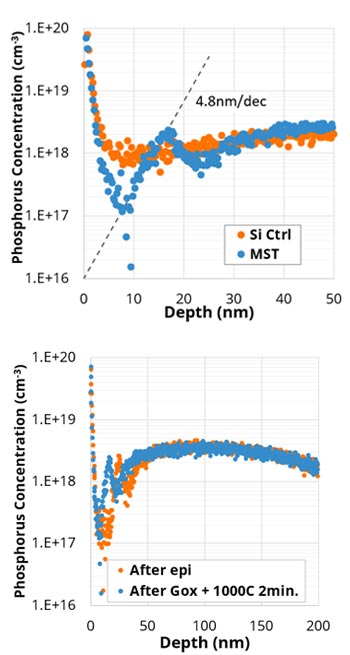Technology
MST - Diffusion BlockingDopant Engineering Controls Diffusion and Improves Performance
- MST can be used to create unique doping profiles
- The dopant concentration can be lowered by an order of magnitude or more, close to the interface with the gate dielectric, where surface conduction occurs, resulting in increased mobility
- Deeper into the semiconductor, the profile of the doping implant is preserved or anchored in place, with diffusion of the implant reduced
- These unique diffusion blocking properties result from the strong interaction between MST, silicon self-interstitials and the dopant atoms. MST significantly retards oxidation-enhanced diffusion (OED)
- MST diffusion blocking and implant anchoring is effective for various dopant species as shown below
SIMS Comparison Between MST and Silicon Control (Si-Ctrl)
MST enables more than 10x lower Boron doping close to gate oxide interface.
MST blocks OED resulting in anchored Boron implant with much less diffusion than Si-Ctrl.
MST Diffusion Blocking for Various Species
Boron
Phosphorus
Arsenic
Indium
Antimony
Publications
Simultaneous Carrier Transport Enhancement and Variability Reduction in Si MOSFETs by Insertion of Partial Monolayers of Oxygen
2012 IEEE Silicon Nanoelectronics Workshop June 10-11, 2012
We demonstrate simultaneous nMOS and pMOS high-field mobility enhancement and variability reduction by inserting partial monolayers of oxygen during silicon epitaxy of the channel layer.
Punch-Through Stop Doping Profile Control via Interstitial Trapping by Oxygen-Insertion Silicon Channel
IEEE J-EDS November, 2017
This paper was invited for a special issue of the IEEE Journal of Electron Device Society based on the high ranking of the EDTM paper of the same title. It is an expanded version of the EDTM paper and includes new material on the TCAD modeling of boron and phosphorus dopants. The paper was written with an additional co-author from Synopsys, which is supporting MST® TCAD.







